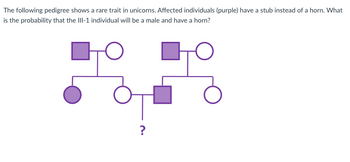
Human Anatomy & Physiology (11th Edition)
11th Edition
ISBN: 9780134580999
Author: Elaine N. Marieb, Katja N. Hoehn
Publisher: PEARSON
expand_more
expand_more
format_list_bulleted
Concept explainers
Topic Video
Question
Possible Options:
A. 1/3
B. 2/3
C. 1/2
D. 1/4

Transcribed Image Text:### Pedigree Analysis in Unicorns
In the study of genetics, a pedigree chart is often used to analyze the inheritance patterns of traits across generations. Here, we have a pedigree chart for unicorns illustrating a rare trait that results in a stub instead of a horn. Affected individuals are shaded in purple.
**Description of the Pedigree Chart:**
- **Symbols**:
- Squares represent males.
- Circles represent females.
- **Shading**:
- Purple shading indicates affected individuals with the stub trait.
**Generations:**
- **First Generation**:
- One male and one female, both unaffected (unshaded).
- **Second Generation**:
- Three individuals: one female (affected) and two males (one affected, one unaffected).
- **Third Generation**:
- One individual indicated by a “?” in a shaded purple square, suggesting that the query is about a potential male individual.
**Question Posed**:
The question asks for the probability that the III-1 individual (descendant in the third generation) will be a male with a horn.
**Inference**:
The III-1 individual is represented as a square with a question mark, suggesting uncertainty about the individual's gender or trait expression. To determine the probability, consider the pattern of inheritance, the sex-linked characteristics, and the phenotypes of the parents. It may involve a deeper understanding of genetic probability, considering whether the trait is dominant or recessive.
Expert Solution
This question has been solved!
Explore an expertly crafted, step-by-step solution for a thorough understanding of key concepts.
This is a popular solution
Trending nowThis is a popular solution!
Step by stepSolved in 2 steps with 1 images

Knowledge Booster
Learn more about
Need a deep-dive on the concept behind this application? Look no further. Learn more about this topic, biology and related others by exploring similar questions and additional content below.Similar questions
- A pediatrician prescribes amoxicillin for a child who weighs 33 pounds. The recommended dose is 20 mg/kg/day, and it's to be administered in three divided doses. The amoxicillin suspension available has a concentration of 250 mg/5 mL.a. How many mg per dose should the child receive?b. How many mL per dose will you administer?arrow_forwardSelect one: a. Aa Bb Ob. aa BB O c. A_ bb Od. AA bb Aa bb e. O f. aa B_ aa Bb g. aa bb Your answer is incorrect. try againarrow_forward5 / 16 100% IAb X O Sign Figure: Lateral view of the right shoulder and upper limb. A. Bone B. Landmark FB C. Landmark D. Landmark Е. Bone F. Bone FD aarrow_forward
arrow_back_ios
arrow_forward_ios
Recommended textbooks for you
 Human Anatomy & Physiology (11th Edition)BiologyISBN:9780134580999Author:Elaine N. Marieb, Katja N. HoehnPublisher:PEARSON
Human Anatomy & Physiology (11th Edition)BiologyISBN:9780134580999Author:Elaine N. Marieb, Katja N. HoehnPublisher:PEARSON Biology 2eBiologyISBN:9781947172517Author:Matthew Douglas, Jung Choi, Mary Ann ClarkPublisher:OpenStax
Biology 2eBiologyISBN:9781947172517Author:Matthew Douglas, Jung Choi, Mary Ann ClarkPublisher:OpenStax Anatomy & PhysiologyBiologyISBN:9781259398629Author:McKinley, Michael P., O'loughlin, Valerie Dean, Bidle, Theresa StouterPublisher:Mcgraw Hill Education,
Anatomy & PhysiologyBiologyISBN:9781259398629Author:McKinley, Michael P., O'loughlin, Valerie Dean, Bidle, Theresa StouterPublisher:Mcgraw Hill Education, Molecular Biology of the Cell (Sixth Edition)BiologyISBN:9780815344322Author:Bruce Alberts, Alexander D. Johnson, Julian Lewis, David Morgan, Martin Raff, Keith Roberts, Peter WalterPublisher:W. W. Norton & Company
Molecular Biology of the Cell (Sixth Edition)BiologyISBN:9780815344322Author:Bruce Alberts, Alexander D. Johnson, Julian Lewis, David Morgan, Martin Raff, Keith Roberts, Peter WalterPublisher:W. W. Norton & Company Laboratory Manual For Human Anatomy & PhysiologyBiologyISBN:9781260159363Author:Martin, Terry R., Prentice-craver, CynthiaPublisher:McGraw-Hill Publishing Co.
Laboratory Manual For Human Anatomy & PhysiologyBiologyISBN:9781260159363Author:Martin, Terry R., Prentice-craver, CynthiaPublisher:McGraw-Hill Publishing Co. Inquiry Into Life (16th Edition)BiologyISBN:9781260231700Author:Sylvia S. Mader, Michael WindelspechtPublisher:McGraw Hill Education
Inquiry Into Life (16th Edition)BiologyISBN:9781260231700Author:Sylvia S. Mader, Michael WindelspechtPublisher:McGraw Hill Education

Human Anatomy & Physiology (11th Edition)
Biology
ISBN:9780134580999
Author:Elaine N. Marieb, Katja N. Hoehn
Publisher:PEARSON

Biology 2e
Biology
ISBN:9781947172517
Author:Matthew Douglas, Jung Choi, Mary Ann Clark
Publisher:OpenStax

Anatomy & Physiology
Biology
ISBN:9781259398629
Author:McKinley, Michael P., O'loughlin, Valerie Dean, Bidle, Theresa Stouter
Publisher:Mcgraw Hill Education,

Molecular Biology of the Cell (Sixth Edition)
Biology
ISBN:9780815344322
Author:Bruce Alberts, Alexander D. Johnson, Julian Lewis, David Morgan, Martin Raff, Keith Roberts, Peter Walter
Publisher:W. W. Norton & Company

Laboratory Manual For Human Anatomy & Physiology
Biology
ISBN:9781260159363
Author:Martin, Terry R., Prentice-craver, Cynthia
Publisher:McGraw-Hill Publishing Co.

Inquiry Into Life (16th Edition)
Biology
ISBN:9781260231700
Author:Sylvia S. Mader, Michael Windelspecht
Publisher:McGraw Hill Education